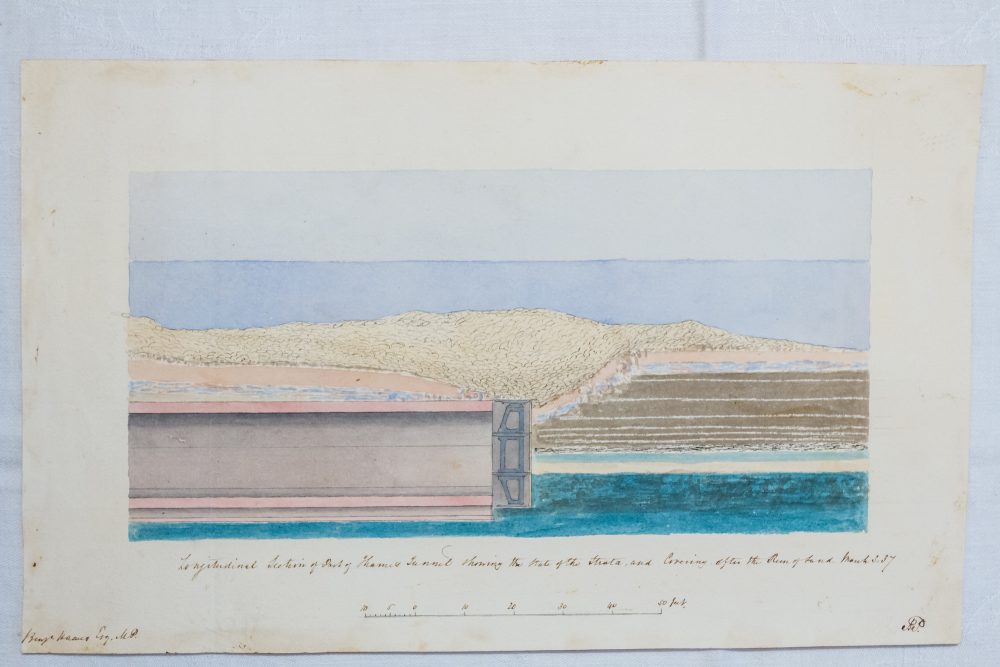Thames Tunnel Archive


Showcase the art of engineering
The Thames Tunnel watercolours are a series of images, hand drawn and coloured by both Brunels during the construction of the Thames Tunnel. They showcase both the Brunels’ unparalleled technical expertise and the surprising artistic skill that went into the Tunnel’s creation. Now we need your help to raise £18, 500 to bring these incredible illustrations out of storage and display them at the Brunel Museum.
Buried in a family album for almost two hundred years, these drawings have changed the shape of our cities and the lives of city dwellers. Yet they have never been on display before. Since the watercolours were acquired by the Brunel Museum in 2017, they have been in storage. The Museum is seeking to raise £18, 500 to purchase a bespoke, safe, archive-quality case to allow us to display these delicate objects onsite at the Brunel Museum.
To thank supporters of the campaign, the Museum have created a series of unique, one of a kind rewards for your donation. Donors can sponsor their very own watercolour or hold a party in the tunnel shaft itself.
The watercolours were acquired at auction by the Brunel Museum in 2017, thanks to the generosity of National Heritage Memorial Fund, Art Fund, V&A Purchase Grant Fund and Friends of the National Libraries.
About the Thames Tunnel Watercolours
The Thames Tunnel was the biggest and most famous construction site in the world, but along the way there was disaster and heroism. Drawings show a daring young Brunel in a diving bell and then in a boat inside the tunnel inspecting the damage by lantern light.
Exceptional for their beauty, artistic merit and technical detail, the drawings have been described as the most important Brunel collection ever to enter the public domain, giving insight into the development of a world changing design that was to transform the lives of city dwellers forever. They are the work of one of our most brilliant engineers.
The archive was once a shopping arcade and underwater fairground. There are 30 drawings in total, prepared or overseen by Marc Isambard Brunel (1769 –1849), during the most important phase of his career as one of Britain’s greatest and most innovative civil and mechanical engineers. Helping him too was his famous son Isambard Kingdom Brunel (1806 –1859) and other talented draughtsmen in the Brunel office; they show the building of the Thames Tunnel between 1825-1843. Construction was only made possible by the invention of Marc Brunel’s tunnelling shield (patented in 1818) which supported the unstable excavating face and protected the workmen. The shield – 38 feet wide by 22 feet high, containing 36 cells in twelve frames over three levels – became the prototype for all future shield construction. The Thames Tunnel is 1,200 feet long and was dug in four inch strips by men working in cages. Inspiration for Brunel’s tunnelling shield came from the shipworm that eats through the wooden timbers of ships with its head protected by a hard shell.
This fascinating archive reveals how Marc Brunel progressed from the gathering of knowledge and experience to confident experimentation with an entirely new construction technique that has changed the course of civil engineering. The designs show in great detail the miners and bricklayers working in the world’s first Tunnel Boring Machine.
Marc Brunel’s Thames Tunnel is the ancestor of the huge tunnelling machines of today, building Crossrail, the Thames Tideway Tunnel and other projects worldwide. These slow moving underground factories that honeycomb our cities are automated developments of Brunel’s prototype drawings. This is the beginning of modern tunnelling.
The archive reveals original working and design drawings of outstanding aesthetic quality and technical clarity and it also offers a comprehensive insight into the development of both Marc Brunel’s career and of his design capabilities, and his famous son, Isambard, just embarking on his career. The Thames Tunnel is Marc Brunel’s most enduring claim to fame (his fame is often eclipsed by his famous son Isambard Kingdom Brunel).
Future Museum
Securing the Thames Tunnel Archive is one of the most important moments in The Brunel Museum’s history. The Museum prepares to embark on a major programme of capital improvements offering level access throughout and enhancing the exhibition area in the Engine House, effectively doubling available space. News of the sale has featured here in the Antiques gazette Thames Tunnel Archive in Auction and in the Daily Mail Tunnel Vision. But the real story: Brunel’s drawing pad is a launch pad for a major building programme, a new gallery, and a new museum for these beautiful drawings – helping this Scheduled Monument tell a very Modern story. Click here to read more about the Brunel Museum Reinvented Project.